How To Beat Level 1 Worlds Hardest Game
M ames used to exist harder. That's the complaining veteran players now complain whenever encountering some mod shoot-'em-up or activity adventure. It sounds similar the aforementioned sort of nostalgic elitism that music snobs indulge in, criticising current bands for lacking the legendary quality of yesterday'south heroes. Only with games, it's kind of truthful.
As the industry has grown, the large titles take moved towards toning downward the difficulty, in order to give a polish experience to every bit wide a range of players as possible. Nowadays, if you want a real challenge, you accept to select "hard" mode, which usually merely means more enemies and less ammo. Merely difficulty is at its best when it's an intrinsic part of the design: players accept to recollect about the game in another mode – and earn their progress.
That is certainly true for the titles in this list. They're not all classics, merely fifty-fifty the patently unfair ones have unforgettable qualities that made us persevere. That'due south the thing with difficulty: it only actually hurts when you want to meet what's next.
Demon'due south Souls/Dark Souls (Fromsoft, 2009/2011)
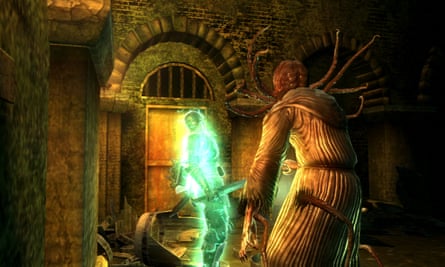
When Fromsoft's Hidetaka Miyazaki set out to rethink the activity RPG genre, one of the new foundations was serious claiming. His thinking was: how can a thespian feel accomplishment without overcoming real odds? In these games, fifty-fifty the virtually bones enemies murder players over again and again, so that the screen message "Yous DIED" is imprinted on the brain. The merely consolation is that expiry is a staple part of how these worlds piece of work. In other games, dying is failure, but here dying is how you lot acquire, how yous get better. In Souls, death is just role of the journey.
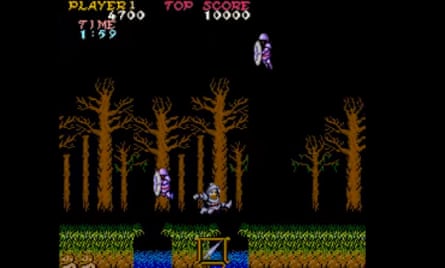
Capcom'southward side-scrolling platformer used the always-present threat of death to create a uniquely intense adventure. 1 hit reduces protagonist knight Arthur to his eye-patterned boxers, and the second kills. Unpredictable enemies spawn everywhere, ability-ups tin be traps, and most players never see past the first stage. Those that achieve the end find out that they've either failed to bring the holy cross, which means replaying the terminal ii levels, or that in bringing information technology they've fallen for "a trap devised by Satan", and have to do the whole thing over again. On an even higher difficulty setting. Capcom, you rascal.
Ninja Gaiden Two (Tecmo Koei, 2008)

Claiming was e'er role of the Ninja Gaiden series, but 2008'due south Ninja Gaiden 2 hit a new peak of demanding insanity. These enemies crude-firm the player on even "normal" difficulty simply, once the setting is at Primary Ninja, they attack relentlessly with roughshod health-chewing grabs and projectiles. In later on levels, foes have cannons for arms that are fire with unerring precision and regularity. Information technology's impossible to survive at times, nevermind kill anything. Naturally, the internet means someone has done the whole matter in iv hours without being hit once.
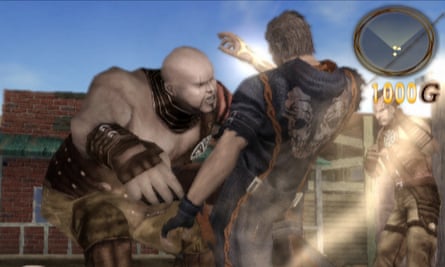
God Hand'south commercial failure means many of the best ideas are notwithstanding to be stolen, one existence the on-screen difficulty meter that responds to a player's skill. There are 4 gradations, from level one to level DIE (the highest level), and if y'all're getting smacked around it stays low. Once you become good at this (already tough) game withal, information technology amps up how enemies attack, where they'll attack from, how much harm they exercise, and increases the rewards for defeating them. Few games make the demands that God Hand does, and none necktie difficulty and performance together with such elegance.
UFO: Enemy Unknown (Mythos Games, 1994)

This is where the XCOM series began, a deep strategy game with an unforgiving attitude towards lax play. The designer, Julian Gollop, had made many great turn-based titles in 2D but XCOM's isometric perspective and implementation of fog-of-war added a terrifying strategic dimension – then many soldiers lost to a night corner you never checked. The aliens exploit mistakes, cut down your soldiers ruthlessly, and back at base strength y'all into hard choices in the drastic scramble to go on humanity safe. If this is anything to go past, we're screwed.
Fade to Black (Delphine Software, 1995)

Flashback's sequel was an early attempt to bring a successful 2D design into 3D – and underestimated merely how important precision controls are. Though a frontward-thinking third-person pattern in some respects, Fade to Black was undone by many enemies that could impale in a single hit – one terrifying instance being a tiny difficult-to-target blob that flips towards the player character before dissolving all their flesh on contact. The lavish cutscenes created by the developer for each possible expiry brand you wonder whether the tail was wagging the canis familiaris.
NARC (Williams Electronics, 1988)

Perchance Eugene Jarvis is better represented by Robotron 2084, an impossible challenge and a much better game, but that low-fi sci-fi shooter lacks NARC'southward crude impact. A two-player arcade game starring Max Forcefulness and Hit Man, out to have down Mr Big, NARC was ane of the first games to truly glory in gibs and ultraviolence – the various junkies, punks and thugs explode into gory gobbets as the guns of justice blaze. Jarvis'south games are always difficult just, with NARC,they reached a whole new level of roughshod theatre.
Nail T.V. (Williams Electronics, 1990)
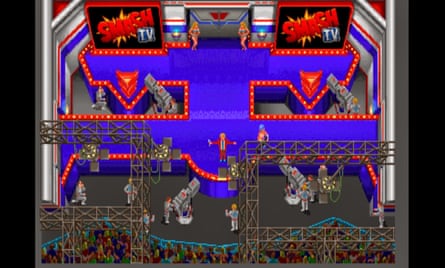
Smash T.V. is an arcade archetype and exemplifies a school of design that's at present largely dead: to make people drastic to encounter the next screen. The setup is perfect, a future gameshow where contestants move through rooms filled with death-dealing nasties and gain more than prizes the longer they stay live. Fifty-fifty the offset room won't hesitate to impale unwary players and, from then on, the gloves come up off equally Jarvis (over again) and co-designer Mark Turmell clasp as much colour, shrapnel, and explosive ordnance on-screen as possible. "Full carnage," shouts the journalist. "IIIIIII love it!"
The Simpsons (Konami, 1991)
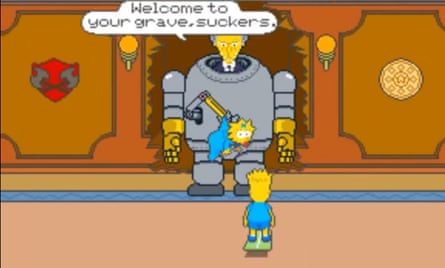
There could be whatsoever number of arcade vanquish-em-ups in this spot – TMNT, X-Men, fifty-fifty Terminal Fight – just in terms of efficiently guzzling coins through gorgeous presentation and artificial difficulty, it's hard to summit The Simpsons arcade game. The visuals, animations, enemies and scenarios are infrequent and clearly a labour of beloved (dissimilar the script) but the game beneath them is a brutal slugfest that especially enjoys stunlocking players – where one hit leads to many more.
Takeshi'south Claiming (Taito Corporation, 1986)
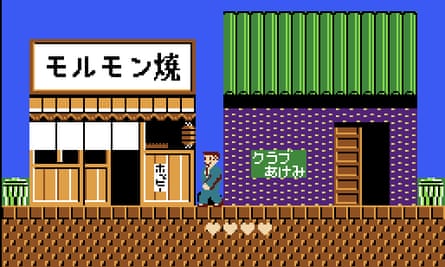
Originally planned as an 8bit version of his TV show Takeshi's Castle, Japanese thespian and director Takeshi Kitano instead got hands-on with Takeshi no Chōsenjō and created a game different whatsoever other – 1 whose packaging warned that "conventional gaming skills exercise not apply". Loosely following a salaryman who dreams of finding treasure, Takeshi's Challenge serves up a Game Over for innocuous "mistakes" like not quitting the character'south job, failing to divorce his wife, or not hitting the right people. Yous tin become a Game Over on the password screen. Another challenge requires you get out the controller untouched for an hour. All games are arbitrary: just Takeshi's Challenge glorifies in the fact.
Rogue (Michael Toy / Glenn Wichman, 1980)

Then original it spawned a genre, Rogue is a procedurally generated dungeon crawler where the difficulty – in the sense of what it chooses to throw at you – is a huge part of the entreatment. Not but will each fresh adventure bring new environmental challenges and fights, just potions and weapons are random too – pregnant just taking a glug is dicing with decease. Players have to be adaptive rather than memorising specific challenges, and eking out a long risk when the odds are stacked confronting you becomes part of the fun.
Dwarf Fortress (Bay 12 Games, 2006)
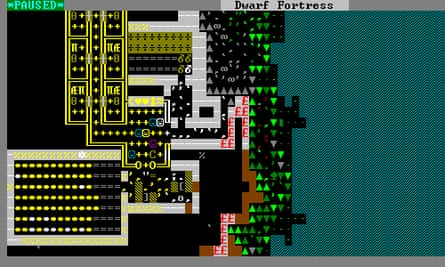
The motto of this game'south community says it all: "losing is fun!" Dwarf Fortress is a game that has inspired whole prose epics on the travails of players' sick-fated settlements, near of which commencement off meagre and then apace fall prey to the thousands of things that can go wrong. Wolves, cave-ins, dearth, cabin-fever, flooding, burrowing downwardly to a demon god … Failure is inevitable, and not merely do your dwarves become mad in arduousness – they oftentimes create works of art to reverberate what'due south happened. There are plenty of tough games, simply generating psychological scars for fictional characters suggests Dwarf Fortress is something special.
The Chance of Trivial Ralph (New Corporation, 1999)
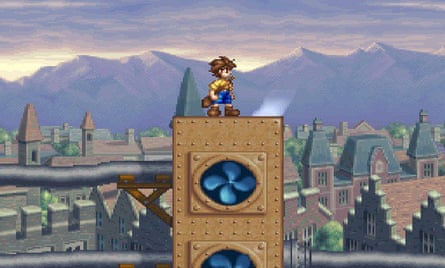
Doomed to curio condition by a small-scale Japan-only release, The Chance of Little Ralph plays like it was forged in the fires of arcade game design, just information technology is in fact exclusive to the original PlayStation and PSN. Scoring focused, hard equally hell and shrouded in cult mystique, the traditional platformer today courts iii-figure sums on the collector market, further denying information technology the wide audience it deserves. Information technology's "saving the dryad in distress" narrative may exist hackneyed, but fiercely demanding dominate fights that reinvent TAoLR as a beat-'em-upward serve to make it mechanically singled-out, and cement its reputation as one of the most testing platformers still adult.
The Baroque Adventures of Woodruff and the Schnibble (Coktel Vision)

Difficulty in games is often a matter of testing the player's ability to control with precision and react at speed. Coktel Vision'southward narratively dark adventure game, withal, is instead a examination of semiotic nous. Its post-apocalyptic tale is told with an abundance of fabricated upward words, many of which pass without definition, while its knack for conversation without context brand information technology thoroughly confusing. Even Clockwork Orange had a glossary. And if you're tempted to use trial and error to fissure its puzzles, be warned that the sheer number of inventory items and illogical quirks make it a protracted, painstaking process.
Mushihimesama (Cavern, 2004)
If any game genre is most synonymous with difficulty, information technology is the arcade 2D shoot-'em-up, known today as the shmup. And information technology is developer Cave that pushes devotees of the form like no other. Which Cave game is the hardest is highly subjective, but in terms of undiluted difficulty, the insect-themed Mushihimesama'due south infamous Ultra mode might take information technology. At that place's less of the mechanical intricacy that makes other releases past the studio perhaps as demanding, but through the sheer number of bullets that fill the screen, Mushi Ultra delivers an onslaught that is as bewildering to watch as it is demeaning to play.
In The Groove (Roxor, 2004)
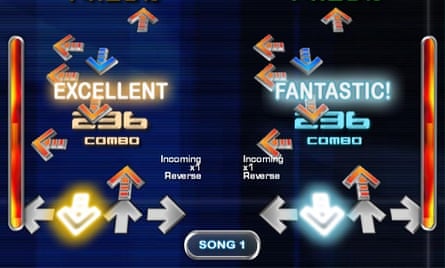
Whatsoever arcade music game has the capacity for towering difficulty. Take on some loftier-BPM electronica on a enervating difficulty setting, and whether you're pounding your feet on a Trip the light fantastic toe Trip the light fantastic Revolution machine or standing over the decks of an oddity like EZ2DJ, the challenge will be immense. Few compare, all the same, to the standard ready by the Unmarried modes of In The Groove, the debut of a short-lived serial from Austin-based studio Roxor. Some of the tracks, when played on the game's X setting, seem to want movement from the player'south body that is in no way catered for by human evolution.
Super Meat Boy (Team Meat, 2010)

If at that place'southward a single moment that defines the experience of playing Super Meat Male child, it is apace prodding the quick restart button. The platformer's undersized stages brim with hazards, yet encourage you to play at furious speed. Equally a result, it's a game of failing over and over once again. Nevertheless, by allowing for split-2nd restarts, there's nearly no drop in momentum as y'all ride the loop of trying and dying. Every bit such, Super Meat Boy works its players into a frenzied trance land from which it can accept hours to recover.
Trials Fusion (RedLynx, 2014)

For a good while, this side-scrolling motorcycling game feels similar a meditative feel – and so the difficulty curve suddenly shoots directly for the heavens. It is then that the game reveals its true form; a nightmarish physics puzzler dressed as a driving game. Just how do you go over that vertical wall? How many degrees of rotation are needed to country on that upside-down ramp? The answer is intimacy with every nuance of a bike's suspension and weight; an intimacy a handful of players globally are reported to have mastered enough to have aced the game'southward closing stages.
Battle Garegga (8ing/Raizing, 1996)
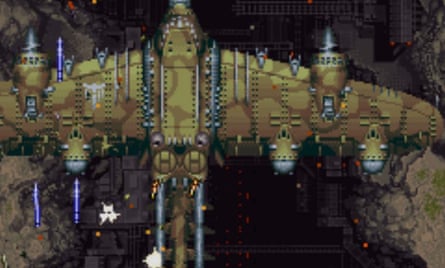
At a glance, Battle Garegga appears to sport a difficulty comparable to your usual 2D shooter: intensely tough, just nothing absurdly so. Even so, it is the way the game makes you lot play that pushes information technology into the "hardest ever" field. Boxing Garegga has remarkably circuitous rank, that is, difficulty, that adapts to the fashion you play. Managing rank to keep the game playable means avoiding some power ups and bonuses, and even "suiciding", where lives are lost on purpose. Playing properly means playing on the edge, life stocks depression and weapon power reserved, and information technology's acutely exciting. The electric current world-tape holder Kamui has held and bettered her leaderboard position through an estimated eighteen years of devoted play, demonstrating the delivery Garegga demands.
Rick Dangerous (Cadre Design, 1989)
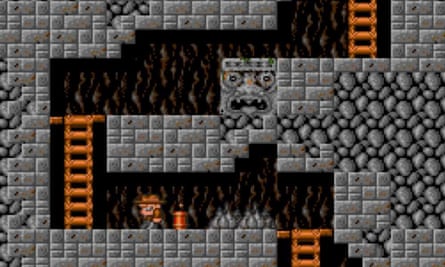
Core's homage to Indiana Jones is a platformer played a few pixels at a time, edging forward to see what will kill you side by side. There are spikes, pits and boulders at every turn, and learning past failing is almost the just mode to proceed. Your inventory is severely limited too, and in that location'due south some tremendously demanding precision needed in a handful of particularly cruel and frustrating sections. Years afterwards, Core would get on to craft another tomb raiding game, by which time the studio had apparently learned how to treat its fans a petty more than fairly.
Shadow of the Animal Ii (Psygnosis, 1990)
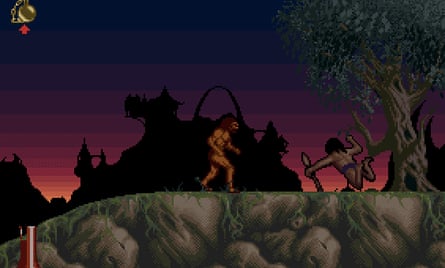
Mention the beginning Shadow of the Beast to the correct oversupply, and you'll likely hear nostalgic musings on how its pioneering use of the parallax scrolling technique pushed game visuals into a new era. Ask about it'southward sequel, and the response may be a petty less rosy. The melee-focussed, multi-directional platform game would have been directly up demanding if it gave you any guidance. Only it doesn't, leaving you to work out everything for yourself. In a time before Youtube and walkthroughs, that alone was plenty to brand Shadow of the Beast II i of the toughest of its day.
Time Crisis (Namco, 1995)
List a familiar lightgun game might seem out of place on a list similar this. After all, anybody who'south visited a dilapidated seaside arcade has likely thrown a handful of coins into the slot of Namco'south cop blaster, and felt null but please. But endeavour and complete the kickoff Time Crisis properly – clearing information technology in a single credit – and it's difficulty begins to go manifest. The lack of a hit indicator leaves a gaping hole in your ability to respond appropriately, and some punishingly curt timed sections serve to make it particularly easy to fast track to the game over screen.
I Wanna Be the Guy: The Flick: The Game (Michael O'Reilly, 2007)
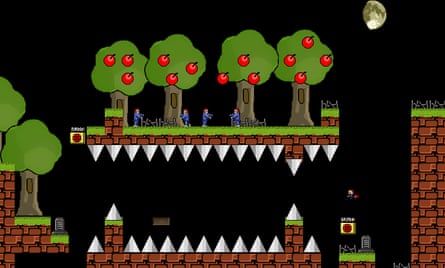
Those who played this freeware platforming treasure that never officially left beta will likely discover information technology hard to forget. Humid its genre down to its founding elements, I Wanna Exist The Guy was developed every bit a response to a then unfinished, brutally demanding Japanese flash game named Jinsei Owata. O'Reilly was convinced he could push Jinsei Owata'south difficulty a picayune farther, and it appears he succeed. As a result, his game has become a reference point for the virtually testing indie titles. Super Meat Boy featured IWBTG's protagonist, The Child, who also starred equally the concluding boss of the conclusive build of Jinsei Owata.
Weaponlord (Visual Concepts, 1995)
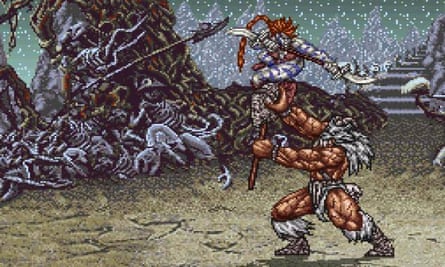
The greatest sin of this straight-to-console beat-'em-up was that it tried to do things differently. Information technology approached the control conventions of arcade fighters from the left field, using a range of weird push combos and d-pad swipes, but the outcome was a circuitous system too demanding for most ordinary players and utterly counterintuitive to committed beat-'em-upwardly competitors. The computer-controlled characters were besides rather too good at their own game, and Weaponlord was ultimately consigned to its fate as a curio most renowned for being the first fighter designed with online play in mind. If you are tempted, the MegaDrive port is a little more forgiving than its SNES cousin.
Flywrench (Messhoff, 2015)
While Nidhogg is Messhoff's most famous game, Flywrench must be its hardest. The set-up is deceptively simple; guide an abstract spaceship through minimal mazes that await altogether innocent, changing colour as you lot pass. The reality is very different, where constantly dying and restarting is the standard. Flywrench is perhaps the most hard game of the past year, or the past nine years, if you were one of the few who played the 2007 original, which saw an understated online release and inspired Braid creator Jonathan Blow to craft a playfully easy version named Nicewrench.
Source: https://www.theguardian.com/technology/2016/mar/18/the-25-hardest-video-games-of-all-time

0 Response to "How To Beat Level 1 Worlds Hardest Game"
Post a Comment